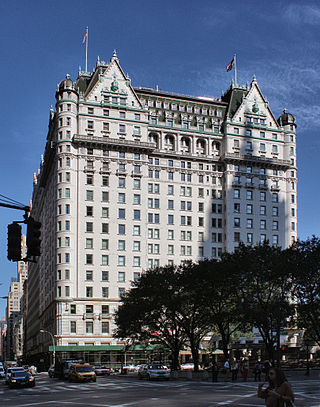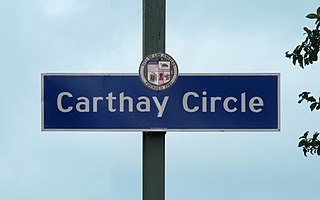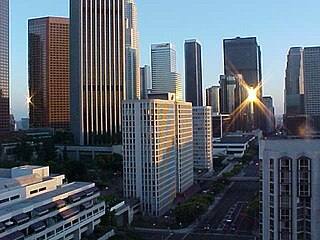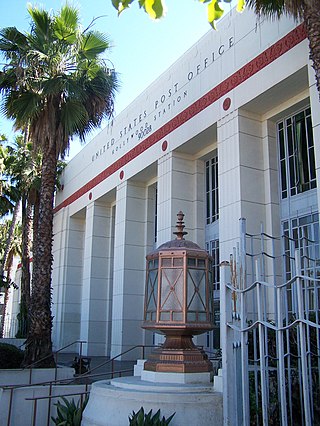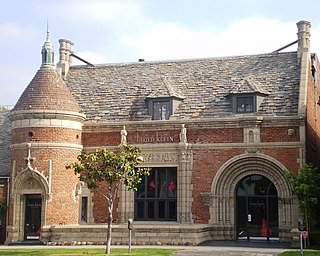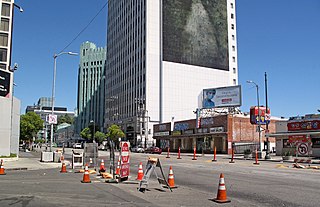History
The building was originally designed for the use of the Benevolent and Protective Order of Elks (B.P.O.E). The building still has a brass sculpture of a set of elk antlers embedded in the clock above the grand entry to the building.
At the time, the Elks membership numbered thousands and included L.A.'s wealthy and powerful. The building contained 169 hotel rooms but was mainly designed for the Elk's activities and events, with lavish interiors, including an impressive spacious foyer, a huge ballroom that could be used as an auditorium, numerous dining rooms, a gymnasium, pool, and a bowling alley. [2]
The architectural expression was eclectic, combining classical columns and arches, stylised Art Deco details, a symmetrical Beaux Arts form with a stepped skyscraper silhouette.
Designed as a memorial to World War I soldiers, the exterior features stylized Assyrian friezes, sculpted figures in military uniform, and massive cast stone warrior angels guarding the plinth and tower at every corner. The lavish interior features an arched ceiling painted by famed muralist Anthony Heinsbergen, who purposely undercut the competition bidding for the job and toiled on his back while painting, like Michelangelo. Heinsbergen later claimed that he rarely bothered with self-promotion again.
By the 1960s, following decades of declining membership and substantial losses at its Los Angeles lodge, the Elks could no longer maintain the building. It fell into general disrepair, and the Elks put it up for auction in 1966. The winning bid was entered by Eugene (Gene) Baur, president of Baur Properties, Inc., a small California family company, which owned and managed the property from 1966 through 1998.
With limited capital, Baur oversaw gradual repairs and restoration using in-house maintenance staff. Of particular note is the restoration of the elaborate hand-painted ceilings that adorn the building's lobby and ballrooms, which had undergone substantial water damage, staining, and peeling under the Elks ownership. Situated in one of the city's most troubled and impoverished districts, and equipped with mostly small, single-occupancy studio units (designed for Elks Lodge members travelling alone), the property was ill-equipped to succeed as the luxury hotel befitting its exterior, lobby, and grand ballrooms. Baur marketed the individual units as low-cost housing for senior citizens and students attending nearby schools, including the University of Southern California, Otis College of Art and Design, and the Fashion Institute of Design and Merchandising. Meanwhile, the building's ballrooms were rented out for low-budget wedding receptions and other events.
In 1983, Baur renamed the Elks Building the Park Plaza Hotel. Seeking additional revenue streams, Baur reached out to film industry location scouts, and by the end of the 1980s, the Park Plaza Hotel had become one of the most filmed locations in Los Angeles. It is featured prominently in Wild at Heart, Less than Zero, The Bodyguard, Barton Fink, The Mask, The Naked Gun, Johns, and The Fisher King, among others. [3] Baur also cultivated partnerships with club and concert promoters, and the Park Plaza gained a second lease on life as one of Los Angeles's hottest night spots, hosting a series of series of successful nightclubs, such as Power Tools, Club Soda, Scream, and Truth, and other high-profile events, including the record release part for Madonna's Like a Prayer album. [4]
Musical artists who have performed live or shot videos at the Park Plaza Hotel include Iggy Pop, Jane's Addiction, Guns N' Roses, Fishbone, Pearl Jam, Ministry, the Traveling Wilburys, Nick Cave, The Fuzztones, Maroon 5, Alice in Chains, and Steve Perry. One of the first rock shows Baur booked at the venue has entered punk rock lore as the Elks Lodge Riot (also known as the Elks Lodge Massacre), an event credited with galvanizing the nascent Los Angeles punk rock scene. [5] Bands on the bill that night (March 17, 1979) included X, the Go-Go's, the Plugz, and the Zeros; however, only the Go-Go's could perform before Los Angeles Chief of Police Daryl Gates, misunderstanding the emerging punk movement as a dire threat to civil society, had his forces raid the building, shut down the event, and violently expel attendees with no apparent provocation. [6]
Upon his retirement in 1998, Baur sold the building, after which a series of ownership groups failed to make the property profitable. In 2016 it was announced that the hotel will be restored by DCGG Park Plaza, the development group responsible for restoring the Roosevelt Hotel on Hollywood Boulevard. [7]




